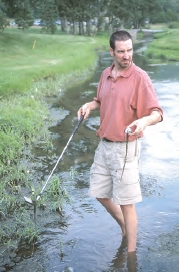DEALING WITH THE PREMONITION OF A BAD SHOT
 Have you ever stood over the ball and felt a bad shot coming on? If you’re like virtually everyone else, you have. What do you do in this situation?
Have you ever stood over the ball and felt a bad shot coming on? If you’re like virtually everyone else, you have. What do you do in this situation?
The obvious solution would be to back off and start our routine over. Yet, almost no one does this. Instead, we try to avoid the shot our mind is focused on. If we feel a hook coming, we may try to hold off our release. If we feel a fat shot coming, we may try to feel like we’re hitting the ball thin. If we realize we are aimed incorrectly, we go ahead and hit the shot anyway, figuring we can adjust during the swing. What happens? You got it – a poor shot is struck virtually every time. We then berate ourselves for not backing off.
Why don’t we back off? The answer may boil down to one word – ego. We know we’ve not been successful in such situations in the past, but we stubbornly insist to ourselves, “This time it will be different!” And, of course, it isn’t.
What happens if we don’t try to compensate for whatever shot our mind is telling us we’re going to hit, and we simply “go with it”? Chances are, unfortunately, we will probably do exactly what we feared we would do. Our body is pretty good at carrying out the instructions our brain is giving it, and this is a perfect example. So, compensating won’t work, going with it won’t work – how do we advise our clients?
Champions Tour player Dick Mast had an interesting take on this problem. He said he backs off and asks himself a simple question: “Okay, then, what do you want to do with this shot?” He then gets a clear picture in his mind and then re-approaches the ball.
USGTF sport psychology consultant Dr. Gregg Steinberg recommends wearing a rubber band around our wrist, and if negative thoughts intrude, snap the rubber band as a wake-up call, and replace the negative thoughts and feelings with positive ones. Both Mast’s and Steinberg’s advice are not designed to be instant cures, but over time, they should give us a better mental routine, complete with fewer negative thoughts.
It is also important that we know whether we are more feel or visually oriented. Jack Nicklaus is very visual, while Tiger Woods is very kinesthetic (feel). Nicklaus seldom took a practice swing. He stood behind the ball, visualized the flight, and pictured the swing necessary to produce it. Woods, on the other hand, can be seen taking numerous rehearsal swings during his pre-shot routine. He has said he has trouble visualizing the exact ball flight, so he uses kinesthetic means to dial in the feel he needs.
In other words, if you are very visual, you probably do not need to take practice swings. If you are very feel-oriented and have a hard time visualizing, you should take a rehearsal swing or two.
Visually-oriented golfers may also not need to practice as much as feel-oriented golfers. Former NHL goaltender Michel Dion, a USGTF Level IV member, said that in the locker room his teammates would often sit and visualize situations they may face during the game. He said that he tried that and it didn’t work for him, as he was more feel-oriented. He compensated by having his teammates take extra shots at him during practice and warm-ups.
Getting back to that moment when we are standing over the ball, there are also times when we feel we can do no wrong, that we are destined to hit a great shot… and we almost always do. Such is the power of the mind.




